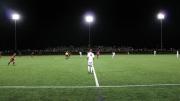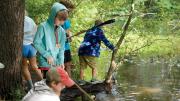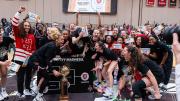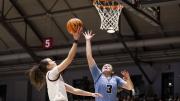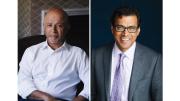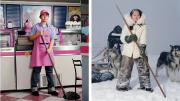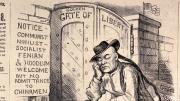In early September, the new, illuminated, artificial-turf Soldiers Field Soccer Stadium opened with a nighttime women’s soccer match against Long Island (a 2-2 tie); the next night, the men took on Stanford (Harvard won, 2-1). Free sunglasses in neon colors, T-shirts, and raffles, refreshments, and prizes served as promotions. The artificial surface allows play in a wider range of weather than the natural grass pitch of nearby Ohiri Field (named for star Crimson forward Chris Ohiri ’64), which “remains the primary site for men’s and women’s soccer now and in the future,” according to director of athletic communications Kurt Svoboda. This fall, Harvard played its first two men’s home games on the new surface, with the final four scheduled for Ohiri; the women split their home contests 4-3 between Ohiri and the new stadium.
“The ability to install lights was important” as a factor in the decision to use restricted funds to build the new facility, Svoboda says. (Ohiri Field abuts a residential community, so installing lights might have created problems.) A lit field allows practice after dark: a useful option when undergraduate resistance to early classes has pushed lectures and sections later in the day. The new surface also enables more flexible preparation for different opponents: if a Crimson side is particularly fast, playing more games on the artificial turf, which speeds up play, may amplify that edge. There is also more space for club and recreational play and for varsity lacrosse, which scheduled games against the men’s and women’s national teams for early October.
Soccer at its highest levels, however, is played on grass. The elite professional leagues of England and Europe, as well as the World Cup matches, take place on natural grass (although this year FIFA, the international governing body, permitted some qualifying matches to go off on artificial surfaces in places like Scandinavia, where it is hard to maintain good grass pitches).
And many players favor God’s sod. “I spring from the grass roots,” says Brian O’Connor ’78, a varsity midfielder in college, who has played on many artificial surfaces. “Nothing equals a well-tended grass field for aesthetics. The ball has a skip off the grass that is unique to its contact with organic matter.” Another varsity alumnus, David Updike ’79, says, “Artificial turf changes the nature of the game, the speed at which it is played, probably induces more injuries than grass, and is less aesthetically pleasing.” For O’Connor, the new man-made surfaces “are much better than the hard, unforgiving turf we sometimes played on in college. But theywill never rival the green, green grass of home.”
